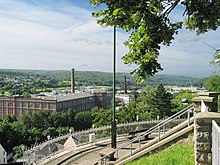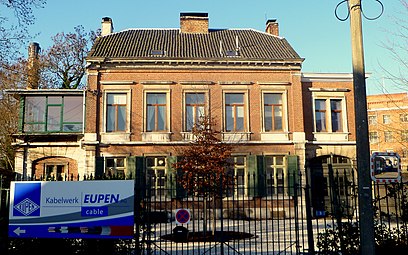Kammgarnwerke AG

The worsted Werke AG was a German company of the textile industry with headquarters in Eupen . The spinning mill was formed on March 19, 1906 on the initiative of the entrepreneur Robert Wetzlar in the town, which at that time belonged to Prussia, from the merger of several individual companies; its location had belonged to Belgium since 1920 as a result of the Versailles Treaty . From 1981 the company was gradually discontinued and in 1989 the company was finally liquidated .
history
After a gradual decline of the over 200 years of flourishing Eupen's cloth industry, in which around 7,000 of the almost 10,000 inhabitants of Eupen had found employment at the best of times, more and more companies ran into economic problems. This is what happened to Eupen's first worsted yarn spinning mill, the Gülcher & Grand Ry company founded in 1890 in the lower town of Eupen. For the conditions of the time, the company was equipped with the latest technical standards and planned to be enlarged from the outset. Shortly after the turn of the century, the company applied for liquidation in order to allow the assets identified in the process to flow into the newly founded worsted yarn factories.
Then, on the initiative of Robert Wetzlar, director of the Wilhelm Peters & Co. cloth factory, several cloth manufacturers from Eupen, Aachen and other German cities decided to found Kammgarnwerke AG as a new, more powerful consortium . This was linked to the intention to become independent of the cartel of the German worsted yarn spinning mills and to establish a dominant market position through the establishment and operation but also through the acquisition of subsidiaries . At this new foundation participated as a partner of the cloth manufacturer Wilhelm Peters in Eupen, the entrepreneur Carl Delius and Joseph Koenigsberg and the company GH & J Croon and Dechamps & Drouven , all in Aachen, and other smaller Operate in Germany. The Aachen-based Rheinisch-Westfälische Diskontogesellschaft supported the project as financier . By bringing in the liquidation assets of Gülcher & Grand Ry , which made up more than 24% of the total capital, the new construction of a colored spinning mill with approx. 23,000 spindles and the expansion of the white spinning mill could now be tackled.
Between 1906 and 1908 new factory buildings were built on the left bank of the Weser . The buildings were erected on the site of the former Gillhausen & Fremerey spinning mill . The architectural office Handel & Franke in Leipzig was commissioned to build the new complex, consisting of a massive four-storey factory building for the colored yarn spinning mill with attached machine and boiler house as well as buildings for the dye works, office, laboratory and porter's house , which has experience with buildings for the Saxon Textile industry decreed. The factory complex is an example of the international level of recognition that Eupen cloth manufacture regained for the last time in the history of the cloth industry in Eupen at the beginning of the 20th century . Theodor Pohl (1862–1932) became the first director of the new Kammgarnwerke AG ; Robert Wetzlar, who died in 1912, took over the chairmanship of the supervisory board . The company received orders from many European countries, and by 1913 the workforce had increased to 681 employees. Main areas of expertise lay in the manufacture of monochrome and meliertfarbigen yarns Vigoureux yarns, raw white yarns in pure wool, blended spun yarns of wool and rayon and blended spun yarns of wool with synthetic fiber admixture
At the beginning of the First World War , the company was initially badly affected by the deployment of German troops against Liège, only 25 km away on the Belgian side, but was able to stay afloat thanks to orders from the warring parties. After the end of the lost war and the takeover of the Eupen district by the Kingdom of Belgium , Kammgarnwerke AG was converted into a company under Belgian law called Filature de Laine Peignée SA . Although the export of Eupen worsted yarn to the German Reich was restricted by new customs regulations from October 1925 , the factory nonetheless remained one of the most important suppliers for Aachen's cloth industry. Theodor Pohl (1863–1932) managed the company until 1928 and had a workers' settlement built in the immediate vicinity of the plant in 1927/1928 through a foundation he set up , which still exists today as Theodor Pohl settlement . His successor was the entrepreneur Alfred Clémens Hubert von Grand'Ry (1872–1943), who had previously worked as a partner in the Ackens, Grand Ry & Cie. and had already held a leading position in the worsted yarn factories since 1906. One of his first actions, which he was able to carry out with significant support from Kammgarnwerke AG, was the implementation of the construction of the Wetzlarbad , an open- air swimming pool that had been financed by a Robert Wetzlar foundation in 1911, but due to political and economic reasons Difficulties during the war and the post-war period could not finally be realized until 1934 under pressure from the widow Mathilde Wetzlar. It was primarily intended to be a recreational activity for the company's employees, and some of them were released as lifeguards during the summer months .
Kammgarnwerke AG went on an expansion course in the following years and took over its branch in Langensalza in Thuringia after the collapse of the Nordwolle Group in 1932 and continued it as a subsidiary under German management as Kammgarnwerke Langensalza GmbH . In the period that followed, sales rose again and, from 1936, the company received larger orders to supply the Wehrmacht. With the beginning of the Second World War , the forced, gradual transformation of the plant into a pure arms factory began. Finally, in 1943, on behalf of the Reich Aviation Ministry, all spinning machines were dismantled and relocated to an old brick factory, so that a department of Junkers Flugzeug- und Motorenwerke AG could billet in the spinning halls, with concentration camp inmates being used as cheap labor. The area, which was now converted into the Langensalza concentration camp , thus became a satellite camp of the Buchenwald concentration camp . The inmates were accommodated in the halls of the worsted mill, which provided accommodation for around 200 inmates.
After the war, attempts were made to make the spinning machines usable again as quickly as possible in order to be able to resume production immediately. The Soviet military administration in Germany in the Soviet zone of occupation issued a decree in 1947 that supported the return of the company, which had been under the Soviet administration since 1945, to the Belgian owners. In 1968 the German Democratic Republic illegally converted the factory into a state-owned company , which amounted to an expropriation of the Belgian owners. After the dissolution of the GDR, the former Belgian owners were compensated with several million DM in 1992.
During the German occupation of Belgium from December 31, 1940 to the end of 1944, the main factory in Eupen was converted into a stock corporation under German law. In 1940, around 76,000 spinning and twisting spindles were in operation in the worsted yarn factory in Eupen, producing raw white and colored yarns for men's and women's fabrics for mainly German customers.
After the war and Eupen's reunification with Belgium, the company was returned to a Belgian stock corporation . In the further course, the worsted yarn works suffered from declining sales, so that from 1956 the neighboring cable works gradually took over the company's buildings for their expansion plans. From 1981 the company was stopped and in 1989 the public limited company was finally liquidated.
literature
- Norbert Gilson: History of the textile industry in the Verviers, Eupen, Aachen area with special consideration of the woolen cloth industry . Rheinisches Industriemuseum, Euskirchen 1997, p. 20 f. and more. ( pdf )
- Leo Kever: Eupener Kammgarnwerke. Robert Wetzlar's plan was realized 100 years ago. In: Grenz-Echo from September 20, 2008.
- Ministry of the German-speaking Community (ed.): The industrial history of the Eupener Unterstadt. Eupen, 2015. ( online as PDF )
Web links
- Worsted yarn works on ostbelgienkulturerbe.de
- Kammgarnwerke share on aktiensammler.de
- Kammgarnwerke Eupen share on papierania.de, lot number: 640
- Entry on albert-gieseler.de
- Collection of the Kammgarnwerke AG Eupen on the website of the State Archives Belgium
- Early documents and newspaper articles on Kammgarnwerke AG in the 20th century press kit of the ZBW - Leibniz Information Center for Economics .
Individual evidence
- ↑ Kammgarnwerke, Buntspinnerei on ostbelgienkulturerbe.be
- ↑ Theodor-Pohl-Siedlung ( Memento of the original from October 9, 2017 in the Internet Archive ) Info: The archive link was inserted automatically and has not yet been checked. Please check the original and archive link according to the instructions and then remove this notice. . In: Eupen aktuell , 23 September 2013, p. 9
- ↑ The Bad Langensalza city archive recalls on hainichland.de, May 29, 2007
Coordinates: 50 ° 37 ′ 16.6 ″ N , 6 ° 1 ′ 55.2 ″ E



